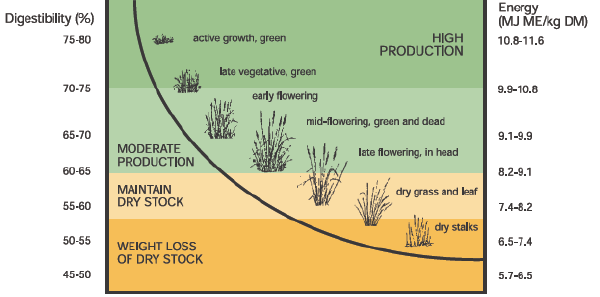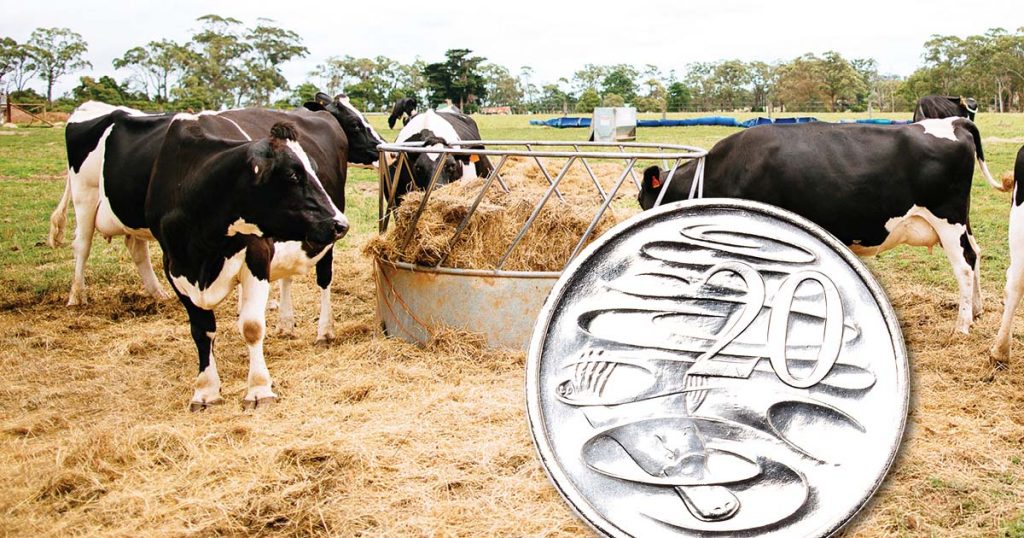The Last 20 Cents; is often the best 20 cents
Most of you will be familiar with the image to the right. It shows that pasture grasses contain the most energy prior to seeding. As seeds develop and the grass dries out, the nutrient value continues to fall. Protein should be considered a type of energy. Without protein the cow cannot utilise other types of energy efficiently to produce milk. The protein percentage of pasture declines at a faster rate than metabolizable energy. Pasture tests show that on the first of October protein percentage is about 30.0%, falling to under 20.0% by the first of November, most likely 10.0% by the first of December, and 5.0% by the first of January depending on where you live and the types of pasture that you grow.
This means that a cow eating 15 dry kg of pasture in October ingests 4.5 kg of protein, 3.0 kg protein in November, 2.25 kg in December and only 1.5 kg of protein in January. To produce any amount of standard 4.0% fat and 3.2% milk a cow must first eat 1.0 kilogram of protein to stay alive and a further 80 grams of protein for every litre that she produces. That 1.0 kg of protein she must eat to stay alive remains the same regardless of how much milk that she is eating (we call this maintenance protein). Let’s see how the cow would go over spring eating pasture and 5 kilograms of low protein grain. A cow eating this diet should have enough energy to make 30 litres in every instance assuming that grass didn’t run out.

As the table shows unless you have irrigation then only in October does the amount of protein provided by pasture exceed that provided by energy. The sharp falls in milk production in November, December and January are almost entirely a result of declining pasture quality as the grasses go to head. Increasing fibre levels, declining sugar levels and possible availability don’t help either.
The nice thing about feeding dairy cows is that they are entirely predictable milking machines. Everything is mathematics. What goes in determines what comes out. This is particularly relevant during springtime. In a pasture-based system we cannot control the natural growth pattern of the grasses that provide the bulk of the cows’ diet, but we can control what we put into the silo to balance out the total diet.
For most farmers with current grain prices, it would cost about $40 per ton to increase the protein percentage of a grain ration from 12.0% to 18.0%. This would lift the amount of protein provided by a kilo of grain or pellets from 120 grams to 180 grams, a nett benefit of 60 grams/kg. If you were feeding 5.0 kg per day to the cows that is an extra 300 grams in total. It doesn’t sound much but it is equivalent to Novembers’ shortfall that wiped 4.0 litres off the milk cheque. Not only that but it would continue to provide that extra 300 grams of protein/cow/day for the rest of the lactation, so the benefit is not a one hit wonder.
Milk not lost has the same value as milk gained. It is easy to measure an increase in lactation because you can see it on your milk chart. That same milk chart can be used to measure a decrease in milk avoided. Look at your previous years results. Most farms feeding low protein in the dairy lose 20-30% of their milk production in November and December so it is easy to see from previous years’ results. If you reduce this drop off to 10-15% of production, then it should be possible to monitor that.
$10 per ton is the same as one cent per kilo. So, $40 per ton is 4.0 cents per kilo. If you were feeding 5.0 kg, then it would cost an extra 20.0 cents per cow per day or less than the value of half a litre of milk. 5.0 kilograms of a low protein ration costs between $1.75 and $2.00 per cow regardless. A low protein ration after November won’t help reduce the inevitable milk drop caused by falling protein in the pasture unless you attempt to replace at least some of that lost protein in the silo or somewhere else.
That extra 20 cents per cow extra should save approximately 3.0-4.0 litres of milk per cow per day for the rest of the lactation. That is why I titled the article the last 20 cents, is often the best 20 cents. I nearly called it “20 cents that Shook the World”, but I wasn’t sure people would get the joke. Feeding higher protein in the bail is a very simple way to maintain higher production over the dryer summer and autumn months that requires no extra time or effort other than thinking about it and calling their Reid Stockfeeds representative to draw up a summer feeding plan.

